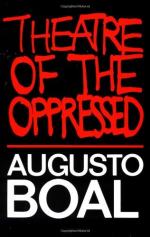|
This section contains 448 words (approx. 2 pages at 400 words per page) |

|
Chapter 1, Aristotle's Coercive System of Tragedy, What does Tragedy Imitate? through What is Justice? Summary and Analysis
In "What does Tragedy Imitate?", Boal presents Aristotle's division of man into an irrational and a rational soul. The rational soul can perform actions, such as eating, that require little thought, while the rational soul is divided into: faculties, all things a man is capable of doing; passions, which are things a man has done; and habits, which are patterns of behavior and being. Aristotle also proposes that man's purpose is concrete good and the ultimate good is happiness. Tragedy imitates man's rational activities directed toward happiness.
In "What is Happiness?", Boal presents Aristotle's three types of happiness: happiness from material pleasure, glory, and virtue. The pursuit of virtue is the subject of tragedy. In...
|
This section contains 448 words (approx. 2 pages at 400 words per page) |

|




